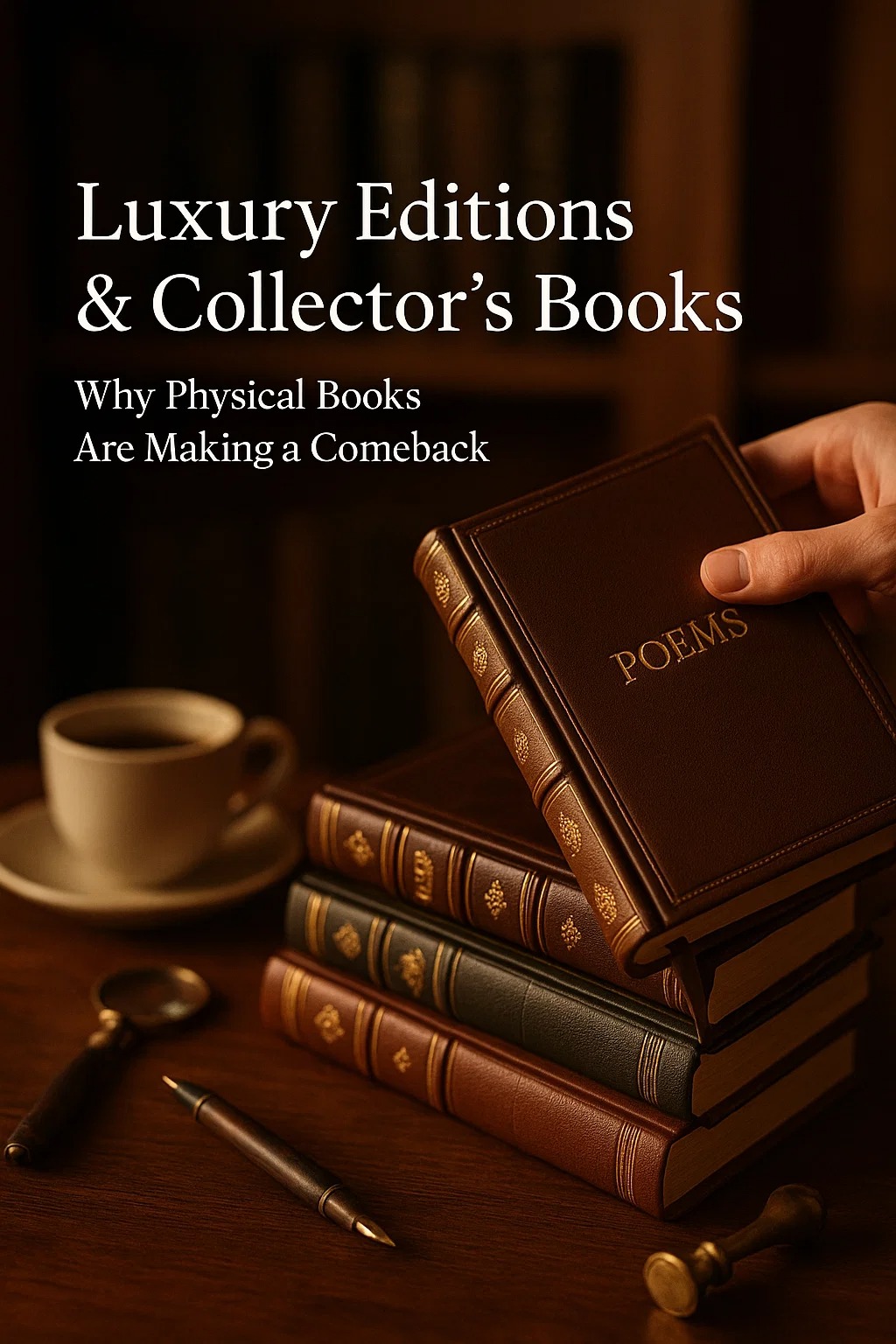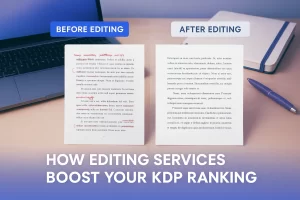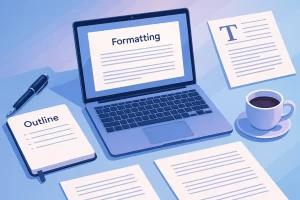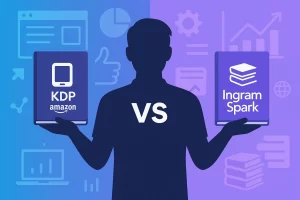There is something unique about print books, the beauty of holding your personal copy. Digital readers prefer the convenience and portability of e-books; therefore, they believe that print books carry weight. Avid new-generation readers who have grown up using digital technology have a strong and surprising preference for print books. To them, having a physical book gives a special feeling that boosts their sensory feelings and deepens their connection with the book. The unique smell of the pages, ink, and cover immerses them in the story. A new book’s aroma, visually appealing design, and texture are invigorating, which entice booklovers to dive deep and read all the way through from the beginning to the end. A tactile engagement without digital distractions brings a focused and immersive reading experience. The increasing digital fatigue and screen overload issues have compelled digital-native generations like Gen Z and millennials to boost their preference to attain a tactile experience. It is also observed in young readers that having physical interaction with a hardcopy or paperback improves focus and leads to better retention while reading a print. Version. The paper texture, smell of a book, and high-resolution illustrations offer a fascinating reading experience that digital formats cannot replicate. Recent data provided by Statista.com illustrates that around 75% of teenage and adult readers aged between 18 and 29 years in the U.S. prefer print books. 32% of American readers merely read print books.
So, whether you are an experienced traditional publisher or self-publishing author or publisher, you prefer physical books for a variety of reasons.
Physical format books, such as hardcover and paperback, continue to dominate the global book market in terms of revenue and sales volume. Physical books are still more popular than e-books and audiobooks among a large segment of readers in the US. The printed book unit sales have risen to 782.7 million units in 2024-2025. The sales report by Statista.com demonstrates that the print book sales in the US from 2005 to 2010 reached the 100-million targeted sales. It determines a 23% increase in book sales over these decades. A 2012 report from NewZoo found that between 2012 to 2025, global e-book sales reached approximately $15 billion. The sales expansion took place due to increased adoption of digital reading devices, smartphones, and tablets.
The recent statistics establish that print manuscripts bring high-income revenue streams for traditional publishers. As stated by the Association of American Publishers’ (AAP) 2024 annual report, around $15.7 billion in revenue from print book format was generated in 2024. An estimated profit margin of the physical book market will reach $70.75 billion by 2029.
Professional book publishing services prefer print publication as they have strong networking with printers, distributors, bookstores, and libraries. Widespread distribution network ensures quick physical book accessibility and sales across the globe. Self-publishing authors and publishers look for cost-effective printing methods, such as modern Print-on-Demand (POD) services that offer mass printing of premium quality, and aesthetically designed books. The deluxe editions have special printing features such as high-quality print runs, metallic foil covers, color reproduction, endpaper art, and graphics on the book covers. Custom illustrations, stunning book covers, unique bindings, and exclusive paper texture transform books into art pieces that continue to entice book lovers.
The exclusive copies have bonus content such as extra chapters, book description, and exclusive backmatter comprising extra scenes and maps. Other special editions include website and social media links to read more about the author and the book. Consumers get book sales coupons and promo codes by signing up for newsletters from specific bookstores. The other exclusive deals comprise a preorder price guarantee and promotional giveaways such as ribbon bookmarks, mugs, and pens, which attract dedicated fans.
Self-publishers sell high-quality, luxurious books of different genres at physical venues, book signing events, book carnivals, and local bookstores. They also distribute their books through online publishing sites such as Amazon Kindle Direct Publishing or IngramSpark, which manage manuscript handling and shipments to customers and online retailers.
In the changing digital publishing landscape, print has found a sustainable place for both traditional and self-publishers to boost book distribution and publicity worldwide. High-quality, eco-friendly editions with splendid cover designs, aesthetically pleasing book layout, and color patterns maximize digital accessibility of the books and bring high sales and revenue.
The Rise of Luxury Editions: Craftsmanship Meets Art
The Folio Society, Taschen, and Easton Press, contemporary luxury publishers, design and print high-quality, collectible editions with leather-bound and gold embossing. The deluxe edition books cover hardback editions of literary classics, fiction, non-fiction, children’s books, design, and photography books. Other notable publishing houses, such as David McKay Publications, have printed a wide range of deluxe editions of books that attract publishers, retailers, and consumers worldwide.
A collaborative process of bookbinders, designers, and print artisans assists the publishing house with preparing new deluxe copies that increase the market value of the print format books. The illustrators and graphic designers work with book layout design, setting the perfect background color patterns, typography, and inserting high-resolution illustrations and decorative elements. Non-commercial printing methods, such as letterpress, are employed by print artisans to create special print pages. For custom binding, bookbinders use exceptional binding techniques and utilize fine materials comprising textiles, custom-printed paper plates that are eco-friendly, premium leather, and hand-marbled paper. Endpaper art from upcoming artists includes embossing designs on the cover and embellishing gold or silver leaf on the edges of the pages. The specialized finishing of the print files involves proficient print specialists to harmonize the cover design with the interior layout. Enhance the visual aspects of the print format that gives a professional look to book packaging, and maximizes book sales.
Collector’s Editions as an Investment
If you are managing an independent book writing service, you might plan to create premium-quality books using superior materials such as exclusive artwork, embossing, and foil stamping. A personal touch to luxury books involves publishers adding customization, special printing effects, and appealing color patterns and textures to the book covers. The front and back covers are crafted from different materials like leather, fine fabrics, and decorative paper.
An exclusive book marketing strategy for luxury books allows publishing houses to focus on enhancing the craftsmanship of the print version. It includes creating attention-grabbing book covers, appealing interior layout designs, visually vibrant typography, illustrations, and special leather bindings that significantly help capture the attention of potential collectors.
Another marketing approach is to create a limited edition of luxury books to create a sense of urgency in potential buyers to quickly purchase the limited edition of the book. The demand for high-end, lavish books increases the market value of books, allowing the publishers to limit the print run of specially crafted editions and charge premium prices. The element of scarcity, combined with consumer desirability, tempts the audience to acquire limited editions with a hefty price tag. Special editions create a buzz and anticipation around the exclusive edition, and attract collectors and buyers to make pre-orders that drive more sales.
Limited and special editions have high demand in primary and secondary book markets. Incorporating the resale market strategy into a luxury book marketing strategy involves publishing companies creating a section for luxury resale on their websites. It helps publishers gain a percentage of resale value. Resale program of a limited number of books includes sending emails to a vast audience, announcing the availability of limited editions of books for resale. The emails also offer preorders and subscriptions that entice consumers to gain early access to purchase their copy.
The social media marketing post includes captivating visuals, book covers, book descriptions, and newsletters that expound the features of the deluxe edition on different social media channels. Exclusive previews and consumer feedback on social media help publishers improve their upselling program. The targeted ads running on Facebook and other channels arouse interest in consumers about reselling and ignite their curiosity to make repeat purchases.
The Role of Nostalgia & Cultural Identity
Let’s suppose you have a deep interest in aesthetic reading trends such as “Dark Academia” and “Cottagecore,” which are subcultures, focusing on different moods, past and modern era lifestyles, and choices. Today, the prominent professional book publishing services have adapted the marketing approach of inculcating cultural themes, rural, and simple living, with a romantic and vintage lifestyle in the deluxe edition. Book marketers incorporate culturally relevant content in the narrative, such as compelling storytelling of the brand’s history, along with traditional norms and cultural themes. A blend of tradition with modern theme, iconic music, and art entice young generation readers to develop an understanding and sense of belonging with cultural experience.
To prevent digital fatigue and boost a comforting connection with the exclusive print edition, contemporary publishers add the element of nostalgia, a peaceful, pastoral lifestyle, and cultural identity. The targeted specific generations, including Millennials and Gen Z fans and customers, get fascinated with medieval cultures, vintage aesthetics, and modern themes. The next generation of readers rediscover the unique connection with the deluxe editions as modern publishers merge tactile and natural aesthetics features that evoke nostalgia and sensory engagement.
Niche publishers are reviving the market for deluxe physical editions by showcasing the authenticity and credibility of the author and their publication. Moreover, they employ striking craftsmanship such as book covers made from linen, leather, natural fibers, wood grain finishes, and rustic lettering that offer aesthetic pleasure to consumers. Custom-made or personalized editions significantly appeal to literary fans and collectors, allowing them to gain an in-depth and more focused reading experience.
Sustainability & Print-on-Demand Innovations
Top-notch book publishing services, such as David McKay Publications, assist independent publishing houses with sustainable book printing. It includes using eco-friendly materials such as recycled or FSC-certified paper, soy or vegetable-based inks, low volatile organic compounds, and sustainable binding techniques to reduce emissions. Sustainable printing minimizes overproduction and waste and also removes environmental hazards. Moreover, digital printing involves publishers using premium printing along with using eco-friendly binding and packaging.
The publishers at David McKay company guide indie publishers to utilize print-on-demand (POD) services, offering low-cost printing. The publishing experts assist new publishers in creating a publishing account on the Kindle Direct Publishing (KDP) site. After having formatted files into the required print and digital format, an indie author uploads the file. As an order is placed, the David McKay publishing team collaborates with distribution partners like Amazon KDP to print single or multiple paperback, hardcover deluxe editions based on the orders received. POD publishers use digital printing techniques for design, binding, and trim size, and add artistry that gives a unique look to the luxurious print format. The publishing house bears the cost of printing and shipping. Deluxe printed versions are packed, labeled, and shipped to the customer. With an extensive global network, the company disseminates the printed versions to online retailers, physical bookstores, and a global audience through its online distribution stores. This cost-effective modern printing technology ensures high-quality professional book publishing and distribution worldwide.
The Future of Physical Publishing
Merging Tradition and Tech
Renowned book writing services employ AI in deluxe editions to generate striking illustrations, personalized layouts, and compelling cover designs that resonate with potential readers. The editors use AI editing tools to refine the text, formatting, and structure of the book. Before crafting a compelling book cover design and layout, the design experts conduct market research through AI algorithms. Knowing about market trends, aesthetics, and audience purchasing capacity allows the publishing house to prepare an elegant deluxe edition to increase sales. With AI design tools, the designers utilize their high-level creativity in creating custom layouts, adding graphics, typography, and exclusive artwork. To create custom covers of deluxe editions, the design and publishing teams jointly work. They employ traditional artwork such as faux leather, quality cloth, and heavyweight paper for book covers and decorate the book edges with fore-edge painting, marbling, edge staining, or gilding that gives a striking impact to the exterior of the exclusive edition.
To further evoke the aesthetic of the book, the publishers use AI techniques for embossing, debossing, and foil stamping. AI image generators create eye-catching illustrations and insert digital elements. Digital tools also create, tactile and visually appealing protective presentation box, or a dust jacket with stunning artwork.
Embedded NFC Chips or QR codes for Exclusive Digital Experiences
Digital technology, such as NFC chips and QR codes, helps in book discoverability and selling limited edition books. NFC chips are embedded in the book’s cover or pages. The readers tap their NFC chips to access content such as author profiles, interviews, book descriptions, videos, and interactive quizzes. QR codes are scanned through a smartphone. The bookstores transmit the bar codes to the web page, providing relevant information about the book, such as book features, pricing, and publishing details.
Personalization, Craftsmanship, and Storytelling through AI will Shape the Future of Print Publishing
Top-rated book professional book publishing services use AI publishing tools to enhance the creativity and aesthetic value of deluxe printed editions. AI streamlines content generation by creating personalized storytelling. An AI algorithm gathers relevant content through fiction and non-fiction books found in the database. It helps publishers to craft compelling plots, settings, characters, climaxes, and dramatic endings. The personalized editions highlight emotional depth, cultural nuance, and aesthetic presentation that connect readers with the characters, theme, and story, and give a mesmerizing reading experience. AI analyzes readers’ choices and preferences and creates high-quality content that is easily comprehensible by readers.
To streamline the book production process and add artistry in special editions, the publishers use different AI tools to automate printing tasks. Prepress Automation helps publishers to identify common printing issues before preparing files for print. AI tools check bleeds, margins, and resolution, color profiles, and maintain standardized formatting. Moreover, AI tools also assist designers and illustrators to refine the cover design of the deluxe edition by adding appealing visuals, exclusive artwork, metallic jackets, foil stamping, double-sided dust jackets, and special bindings that create a lasting impact on the buyers.
Many book writing services have adopted Hybrid publishing. The future hybrid publishing model allows authors and AI tools to collaborate to produce engaging content. The authors are using new AI-driven storytelling techniques to incorporate creativity, personalized story elements in deluxe printed formats. High-quality content adds exclusivity and entices potential readers to take immediate action to purchase their deluxe copies.
How Indie Production Teams Improve the Content Quality of Premium Editions
To increase the deluxe book’s production value in the market, the authors collaborate with designers and printers to create a small-batch, luxury run of the book. Partnering with a printer implies that authors find a professional book publishing service that competently handles the printing of luxury editions. The authors and publishers reflect on the premium quality materials and aesthetics used to create luxury editions. It includes using acid-free, thick paper, foil stamping, and debossing/embossing on the book cover. Adding exclusive artistic and design elements to enhance the interior layout of the book. Luxurious bindings include premium cloth, leather, or imitation leather binding.
The designers and authors work together to create aesthetically pleasing book covers. The designers set perfect fonts, the margins, jacket design, foil stamp, and custom artwork to create outstanding, luxurious book covers. In the final phase of book printing, the entire production team, comprising authors, designers, proofreaders, and printers to analyze the digital file to check text flow, image placement, color accuracy, foil stamping, and the quality of the binding.
Publishers and Marketers Build Brand Identity through Premium Design Books
Renowned publishing houses have re-engaged the book market by launching luxury editions. They modify the backlist titles and classics to create a premium edition by enhancing the aesthetic of the book. High-quality production, including clothbound, leatherbound, foiled covers, embossing, and sprayed edges, attracts collectors and gives a pleasurable reading experience.
The marketers create targeted digital marketing campaigns to promote deluxe edition books on online platforms. It includes launching social media posts, videos, and paid ads on Facebook, BookTok and Instagram, where the aesthetic of the book is a major selling point. Targeted ads on Amazon and Google entice potential readers to gain information about special edition books. Email marketing allows marketers to send emails to a vast audience. The emails announce the release of the deluxe edition and share exclusive excerpts, quotes, and video trailers that lure buyers. Moreover, special offers such as pre-order bonuses and discounts incentivize readers to make early purchases of the limited-edition book. The influencers, book bloggers, and YouTubers also enhance book discoverability and sales.
Recapitulate
If you are an avid reader and desire to gain tactile experience, you must read deluxe edition books. These unique and special edition books stand out in a saturated publishing landscape due to their high-end materials and exclusive artwork that turn them into collectible art. Deluxe editions fascinate readers as they boost their sensory experience. The premium materials used for book printing, such as high-quality paper, textures, fabric, faux leather binding, embossing, and foil stamping, increase a reader’s physical sensation. Moreover, eye-catching book covers, elegant designs, custom illustrations, and appealing artwork seize the reader’s interest to purchase the limited edition. Though a limited edition of books is more expensive to produce, they increase the book’s value in the market. To sell deluxe editions, the publishers and marketers adopt a strategic marketing tool. It implies that marketers develop special editions and create the fear of missing out. Limited availability of special editions attracts collectors and superfans for their uniqueness; it arouses interest and curiosity in buyers to make early purchases before the publisher stops printing and distributing a specific version. This lucrative marketing strategy increases fanbase, brings more pre-orders and initial sales, and helps publishers gain a higher profit margin. The top-rated book publishing companies create artistically pleasing, high-quality books to boost brand image. By re-engaging in the market, the publishers create an entirely new, premium edition of the classic and backlist title. Adding craftsmanship to luxury editions elevates their aesthetic and also increases market value and price point. As deluxe editions stand out as unique in the competitive market, the authors enhance their visibility and brand awareness among readers who value premium print editions. Thus, exclusive content, including bonus chapters, stunning book covers, artwork and signed copies, boosts the book’s marketability on online platforms and brings more revenue streams.




